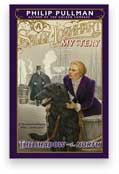The Shadow in the North review
 Shadow in the North, a Sally Lockhart Mystery by Philip Pullman (author of The Golden Compass), is one of those books that makes a reader want to step in and wrest the characters’ destinies from the author’s hands, and I suppose that’s a sign of a good if infuriating book.
Shadow in the North, a Sally Lockhart Mystery by Philip Pullman (author of The Golden Compass), is one of those books that makes a reader want to step in and wrest the characters’ destinies from the author’s hands, and I suppose that’s a sign of a good if infuriating book.
Shadow in the North is another contribution from my friend Mike and it was recently dramatized on PBS Masterpiece (a BBC One production), and to my recollection it was a faithful adaptation. It is the second of a series, the first being The Ruby in the Smoke, and follows the adventures of Sally Lockhart, a young woman who must make her own way in life after the death of her father. In the first book, she befriends Frederick and Webster Garland, nephew and uncle photographers, and together with Jim Taylor, who had been an office boy in her father’s firm, they combine their abilities. Her father taught her much of the business world and she becomes a financial consultant — a very, very unlikely employment for a single Victorian woman — while Taylor and the Garlands become private detectives of a sort. Oh, and Sally is in love with Frederick but will not marry him because she fears the loss of her independence. At the time of the story, a woman’s property became her husband’s upon marriage.
The second story has three tracks that will converge: Sally is investigating the collapse of a shipping company that has left a client penniless, Jim helps a magician fleeing from pursuers who wish him no good, and Frederick is investigating a medium who seems to have troubling knowledge of financial dealings. Add to this a shadowy financier, Axel Bellman, whom Sally believes at the heart of the shipping company’s collapse, the beautiful daughter of Lord Wytham (disgraced by his financial position and fall from his position in the government), a contract killer who takes pride in his work, Sally’s fierce dog Chaka, and numerous sympathetic and/or colorful witnesses and you have a busy plot, although to Pullman’s credit it all comes together plausibly at the end.
The novel also has a nice steampunk element, however being first published in 1986 and before steampunk really became a genre, it has none of the trappings. The central steam device fits neatly into the Victorian technology and politics of the time, a time when governments and monarchs worried about the rabble and revolutionaries threatened the established order.
I found the tragedies in the book as hard to take as they were in the PBS version and I thought them unnecessary, but I cannot say whether the book would be improved by removing them. And unfortunately I found the ending a little messy where Sally, reeling from the tragedies, essentially braves the villain in his lair with little more plan than concealing a gun. I recall being more able to ignore the absurdities of the success of her plan in the PBS version than I was reading the book.
Another aspect of the book I found troubling is the role that spiritualism, psychometry and telepathy played in advancing the plot. Half the time the book dismissed the genuineness of the supernatural and half the time it depended on it to reveal answers. I call your attention to examples from Sherlock Holmes, who consistently dismissed the supernatural as the explanation for a mystery, and who also said that he did not alter his fees save when he omitted them altogether. I would have preferred that Pullman had either embraced the supernatural or omitted it altogether and simply stuck to detective work to supply the answers. (Incidentally, I believe the PBS/BBC version more fully embraces the supernatural in the ending.)
But the above is a very minor quibble and my own prejudice. I’m sure the majority of readers will enjoy reading The Shadow in the North, even if no one can enjoy Pullman’s heartbreaking decisions.
